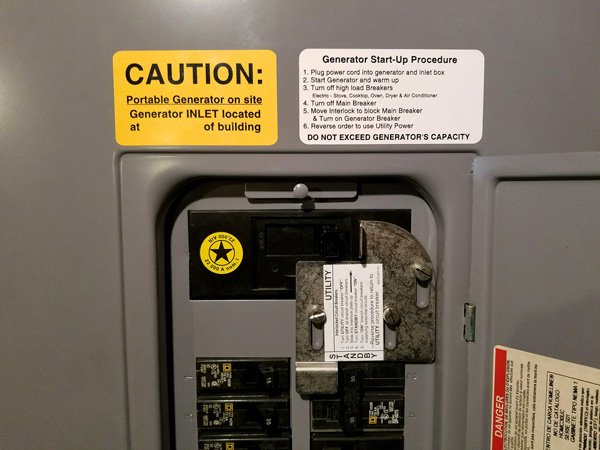A generator interlock is a device that helps in managing the power source to the panel. It is the interlock’s job to ensure that the generator circuit breaker and the main circuit breaker cannot be switched on simultaneously. The interlock assures the line worker’s safety of who is working on the electrical lines. These devices help in preventing dangerous electrical back feeding into the utility lines.
How Does A Generator Interlock Work?
An interlock is manually operated. When installed, the interlock helps move the main power breaker to the generator breaker when the power goes out. The trained technician will turn off the main breaker and all the other breakers to set the interlock switch to the generator, following which the generator is engaged. The main breaker powers the panel, and then the respective breakers are turned, as required.
In other words, a generator interlock kit helps in safe back-feeding of power through a generator during power outages. As a result, unsafe situations such as generator backfeeding can be eliminated that can potentially damage the generator or even kill a power company worker!
The installation of an interlock kit is a complex process. Therefore, you must hire a professional electrician who can tackle the job for you. An interlock kit is installed by joining two sliding metal or plastic plates with the help of three bolts on the breaker panel’s front cover.
When the switch is moved down, the plate obstructs the generator backfeed circuit breaker and keeps the main breaker on. When moved up, the main circuit breaker remains blocked while the generator backfeed circuit breaker gets switched on. As a result, the electricity from the generator is unable to travel through the panel and back into power lines.
Why Do You Need A Generator Interlocking Kit?
While everyone knows what a generator interlock kit does, but not many understand what it means for their own home and how they can benefit from it.
As has been explained before, a generator interlock kit is designed in such a way that it allows for safe backfeeding through a generator, thereby eliminating the risk of electrocuting the lineman. But how does that benefit you? For that, you need to understand what backfeeding means.
Backfeeding happens when electric power is being diverted back into the power grid. Due to the opposite course of the power from its normal flow, the activity is deemed illegal and unsafe.
Some people remedy this situation by installing a manual transfer switch. However, the challenge with this solution is that you would require multiple extension cords to connect your appliances to the generator, creating an unsightly web of wires in your home. Apart from being an eyesore, these cords are also a fire hazard, not to mention the risk of tripping and falling.
Another issue with the manual switch is that big appliances such as water heaters and furnaces cannot be connected to an extension cord, rendering these devices useless during a power outage.
Fortunately, you have a solution to this crisis – an interlock kit. This device is not only more affordable than transfer switches but also provides a more robust solution.
With the help of an expert, you can easily get an interlock device mounted on your existing panel. You can also get your electrical panel updated from the same technician and seek guidance in choosing the right generator.
When to Use an Interlock?
A generator interlock kit is best suited for small commercial and residential units where continuous power is unnecessary. While they are simple to operate, you may require additional power management to switch off the breakers for circuits that go beyond the generator’s capacity.
The best applications for interlock are:
- Residential or smaller commercial establishments
- Units that do not require continuous power
- Sites where someone can manually operate the interlock kit
Since interlock sets are less sophisticated, they are, therefore, more cost-effective than transfer switches. However, they do require adequate training and understanding of the building’s electrical system to perform the job of installation.

